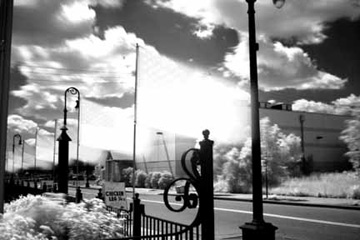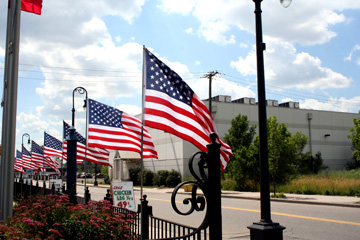
Home > Essays > Flags in Infrared

Trees and rivers are perhaps the most popular subjects for infrared photography. Dark trees and bright rivers make for a very interesting switch when photographed in infrared. But flags are interesting, too. In the case of the American flag, the blue field with its white stars makes for a stark contrast to the alternating red and white stripes. Is the blue field made of a different fabric than the red stripes? And if so, would this difference show up in an infrared photo?
Prior to taking these photos, I had experimented with photographing a couple of different fabrics dyed dark colors and found that they showed up as essentially white in infrared photos. It wasn't until much later that I did any basic Internet searches for information on flag textiles.
According to Prof. Barbara Gatewood of Kansas State University (link at the bottom), "early American flags were made from wool, cotton, linen or silk." But of course such flags would be in museums likely on the East Coast, not waving in the parking lot of a supermarket in a Midwestern city.

However, even today, cotton is used for flags for indoor use. Polyester withstands rain and wind better than nylon but nylon is said to wave better and with more "snap." The most interesting tidbit to me from the Kansas State article is this: "The most common method for assembling the American flag throughout history has been sewing pieces of dyed and undyed fabric together and then sewing or embroidering the stars onto the blue material."
This might help explain why star on field detail is not completely lost when photographing flags in infrared, though in some cases it might require an almost posterizing Levels or Curves adjustment in Photoshop to retrieve it.
I'm not talking about false color thermal infrared photography here, it should be noted. Nor was I using a camera internally modified for infrared photography. All I did was attach a visible light blocking filter to the lens, and a polarizer, too. I can't remember if I also used a red filter for these photos, though I do remember using that for other infrared photos. Nor do I remember if I took off the UV filter for these, a filter which was otherwise permanently affixed to the lens.
Regardless of whether or not I used the red filter, photos taken with the visible light blocking filter showed up on the memory card with a soft red color wash, as if a black and white photo was tinted red. In Adobe Photoshop it's a simple matter to turn these to black and white.

And of course I used a tripod. With the visible light mostly cut out, a significantly longer exposure is required (30 seconds at f/8.0), and of course the flags waving in the wind introduces quite enough potential for blur as it is. As you can imagine, my memory card that day had quite a few unusable photos. I needed plenty of time. That day was Sunday, July 5, 2009.
The photo shown above at the top has been exhibited in a gallery twice: first in 2013 at the 4731 on Grand River Avenue in Detroit, and again in 2014 at Corktown Studios, also in Detroit. At the latter it was part of the Capture: A Dialogue Between Paintings and Photographs show. For that show, Sanda Cook did a charcoal drawing of the flags.